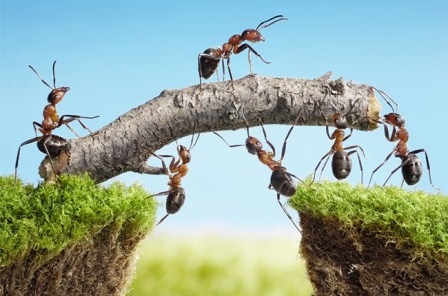The Website that United the World (and Made Collaboration Cool) by Holger Reisinger of Jabra.
 Forget about ancient monuments, modern superhighways or space exploration. The world’s most impressive collaborative effort is right at your fingertips. Find out what it is and why it’s revolutionising how we share information and solve problems.
Forget about ancient monuments, modern superhighways or space exploration. The world’s most impressive collaborative effort is right at your fingertips. Find out what it is and why it’s revolutionising how we share information and solve problems.“What is the greatest collaborative effort in history?”
It sounded like a simple question. But for a few moments, it had most of us in the “New Ways of Working” team stumped.
As we went around the room, most cited one historic achievement or another: The pyramids. The London Underground. Space travel.
As we got near the end, the youngest on our team, sitting quietly in the corner, spoke up.
The room fell silent for a moment, and then everyone began nodding in agreement. More than a few muttered incredulously “Why didn’t I think of that?”
I must confess. I hadn’t thought of it either. But she’s right.
Wikipedia, that humble-looking, information-packed site we all visit daily (actually about 333 million times a day) to me represents the most important collaborative effort in history. It’s barely a teenager, but its impact has been almost incalculable and equally far-reaching, especially in today’s knowledge-is-everything economies.
Whether we’re researching the reign of Queen Elizabeth II, exploring the theory of relativity or settling a bet about FC Bayern’s 1996 won-loss record, Wikipedia is our one-stop source for information about… well, practically everything.
The Combined Work of Thousands of Volunteers
What makes Wikipedia so incredible isn’t just that it’s the world’s seventh-most visited site by visitor traffic. Or that its 35 million-plus articles worldwide rack up an astounding 10 billion pageviews from some 495 million unique visitors each month.
What’s truly amazing is how it came about. Not through a government grant or deep-pocketed corporation, but through the efforts of thousands of volunteers who collaborated to build the site, dedicating their time and expertise to sharing the wisdom of the world with everyone.
Even today, a network of 70,000 active contributors formally known as “editors” (and more informally called “Wikipedians”), augmented by an untold number of others, create and edit content for the site. The effort is truly the textbook definition of collaboration; that is, the act of getting people together, either physically or virtually or both, to turn problems into solutions.
Power…. Or At Least Information… To the People
And Wikipedia didn’t just solve the problem of how to create, store, retrieve and disseminate information, it obliterated it. Before the site came along, information was bulky, expensive and often hard to find. Wikipedia rendered obsolete the massive encyclopedias that cost a fortune, provided limited information and were out-of-date moments after they were printed.
By contrast, Wikipedia is readily accessible, takes up zero space and is free (Wikipedia is a non-profit, sustained by donations). It has removed information from the hands of the few and placed it at the fingertips of all. More than just a way to confirm our opinions, it enables us to open our minds to new subjects and ways of thinking.
Perhaps most important, along with being the byproduct of collaboration, Wikipedia also fosters new ways of collaboration. Thanks in part to it, virtually every organization today shares information internally using wikis, miniature knockoffs of Wikipedia. In a sense, Wikipedia served as a role model, instilling the discipline of sharing and creating knowledge collaboratively with colleagues with whom we share interests. This has made the ongoing challenge of sharing knowledge throughout a distributed workplace an easier task.
I can appreciate all that went into building the pyramids, exploring the vastness of space and constructing the Tube. But when it comes to its sheer impact on us as humans, I tip my hat to Wikipedia, history’s greatest collaborative effort.
Additional information
To learn more about new ways of working, read Jabra Holger Reisinger’s blogs by Clicking Here
For additional information visit the Jabra Website or view their Company Profile





